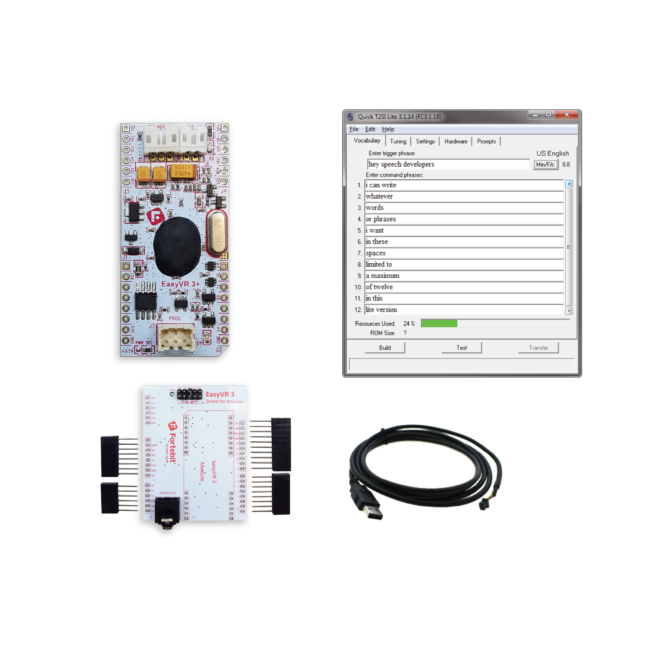EasyVR 3 Plus Development Kit
As low as £164.10 £136.75
EasyVR 3 Plus Features
The EasyVR 3 Plus module can be used with any host with a UART interface powered at 3.3V – 5V, such as PIC and Arduino boards. Some application examples include home automation, such as voice-controlled light switches, locks, curtains or kitchen appliances, or adding “hearing” to the most popular robots on the market.
EasyVR 3 Plus allows up to 64 user-defined Speaker Dependent (SD) or Speaker Verification (SV) commands, that can be trained in ANY language, divided into maximum 16 groups (up to 32 SD or 5 SV commands each).
Quick T2SI Lite
- The Quick T2SI™ supports the following languages:
EasyVR Shield 3 Adapter Features
The Shield is compatible with any Arduino board using UNO-R3 Shield headers, running at either 3.3V or 5V levels, by using the IOREF pin to select the EasyVR operating voltage.
It is also backward compatible with earlier Arduino boards that don’t have the IOREF pin, which are using 5V I/O levels by default.
If your board does not have the IOREF pin but it is running at 3.3V, you can still operate the EasyVR Shield 3 correctly if you manually connect pins IOREF and 3V3 together, for example with a jumper wire.
The board comes with separate Arduino stackable headers for the Shield interface. The EasyVR 3 module is also provided separately.
QuickUSB 3.3V Features
QuickUSB is an USB-to-UART adapter cable, easy to use and supported on all the major operating systems.
It plugs into a standard USB port and brings all the UART signals to a compact 6-pin 2mm pitch female connector (Hirose DF11 Series).
It can be used to connect an EasyVR3 module directly to your PC, without any other adapter boards.
Download Links
EasyVR Arduino Library v1.10.1
EasyVR Arduino Library – All versions (on GitHub)
Home Automation Grammars for EasyVR
EasyVR Application Note – SD/SI commands and functions rev2.0







